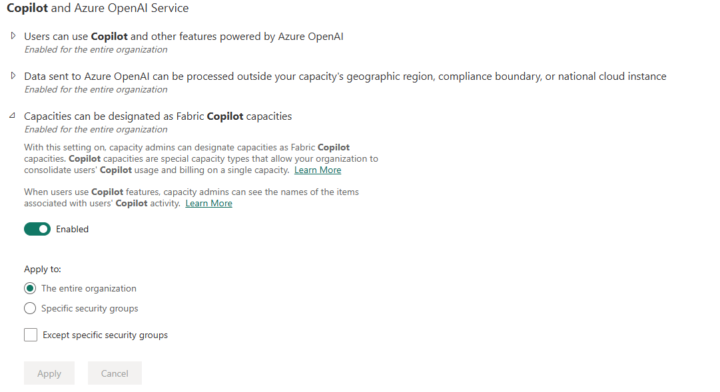Activity
Mon
Wed
Fri
Sun
Oct
Nov
Dec
Jan
Feb
Mar
Apr
May
Jun
Jul
Aug
Sep
What is this?
Less
More
Memberships
Fabric Dojo 织物
339 members • $447/y
Learn Microsoft Fabric
12.7k members • Free
7 contributions to Learn Microsoft Fabric
[DP-700] Decision Guides in Microsoft Fabric (NEW!)
NEW ⚡ Making decisions about when to choose which items in Fabric is a common problem: Lakehouse vs Warehouse, Pipeline vs Dataflow vs T-SQL vs Notebook etc, and it can cause some confusion... These decisions come up a lot during the DP-700 exam also, many times you will be presented with a particular scenario, and you will be asked which item is best suited to the problem - both in terms of data storage and transformation. In our latest video (just released now!), we take a look at the Microsoft Decision Guides for Fabric data stores, and data ingestion/ transformation. Plus we also cover Shortcuts and Mirroring. 👉 📽️ WATCH HERE: https://youtu.be/lPCBGOStKU4 👉 📽️ Also, earlier this week, I posted about Orchestration in Microsoft Fabric, watch that one here: https://youtu.be/U7t9j95d1WA This marks the halfway point for our DP-700 series, but we've still got a lot of big topics to come! Next week, we'll start diving into Data Transformation using T-SQL and PySpark - see you then!
![[DP-700] Decision Guides in Microsoft Fabric (NEW!)](https://assets.skool.com/f/f412933e1c184e088b4b132d5244b875/f2fc31df57dc4a5480d6362f386cf749cb45bd78a03744718b1ea0e8c01c327a-md.png)
Fabric January 2025 Product Updates
Hey everyone, it's time for the first Monthly Product Update: January 2025. 👉🔗 Microsoft Fabric January 2025 update Take a look through, and let me know which one(s) you're most excited about! 👇
0 likes • Jan 30
@Will Needham from end-user / consumers perspective: I think it always depends on how Power BI/(Fabric) is used in the company. Especially in smaller companies, I've experienced that most of building semantic models and even admin/infrastructure work is done by data-savvy business users rather than IT professionals. They are usually not familiar with any kind of CI/CD processes, so in such settings a version history for semantic models is already a big advantage.
DP-700 Exam Prep Series: begins today
Hey everyone, excited to launch the DP-700 Exam Prep Series (on YouTube, and here in the Learn Microsoft Fabric Skool). Just released the first video, an introduction to the exam, and the series: https://youtu.be/XECqSfKmtCk Notes and links available here: #Introduction to the DP-700 Exam Please like, share, leave a comment (on YouTube) and all that stuff - it helps others to find the content too 😀 Any questions about the DP-700 or the series, let me know, happy to help!

Reduce Fabric CU usage and cut costs with a hybrid PBI Pro & F-SKU workspace model
The licensing for Microsoft Fabric can be confusing to newcomers, especially when you are introducing Fabric as your in-house ETL tool whilst migrating existing PBI reports to the platform. Below is some information that may be most relevant and useful for individuals running an "F" SKU below F64, or that do not use Fabric scaled to F64 all the time and also possess Power BI Pro Licenses. "Why is F64 relevant?" - When running workspaces licensed to Fabric on F64 or above, individuals can consume Power BI reports using a Fabric Free license. I.e. you do not need to purchase a Pro license for such users. "But I don't have a need for F64. My user base is also far below the threshold to make it worth my while to scale up to F64 to save on the Pro license costs!" - Also fine. This post is for you specifically, and intended to advise how to keep your costs as low as possible as you grow, with being smart about your workspace layout. Imagine you're a smaller use-case business, with only 40 Power BI users with Pro licenses to consume their PBI content. Maybe in addition, the Fabric-specific content you are creating (Pipelines, Notebooks, Data Flows) requires only F4 / F8. Far below the threshold to be thinking about scaling up to F64. Maybe also you only use Fabric once per day to run ETL pipelines, at which point the only use of the SKU is for users consuming those PBI reports. You can cut your Fabric Capacity Unit usage if you do the following: 1. Keep your PBI Semantic Models and Reports in a separate workspace to your Lakehouse / Warehouse / Notebooks essentially split the PBI content from the Fabric content. 2. License the Fabric workspace to Fabric, and for the PBI content workspace, use the Pro License method. What does this do? Splitting your content in this manner means that the PBI report consumption will not count towards usage in the Fabric workspace. This means you can switch off the workspace entirely, thus ultimately cutting costs. You're fully utilising your Pro Licenses to host the PBI workspace, and don't have to run Fabric all day long.
Introducing Fabric Copilot capacity 😯
Wow! This one's a pretty big shift. See the full blog for more details. TLDR is that from end of January, in the Capacity Settings for a given capacity, you will be able to designate the capacity as a 'Fabric Copilot Capacity (FCC)', then you will need to assign Copilot users to this capacity (see images). Importantly, this means that users assigned to an FCC can use Copilot in these scenarios: - Power BI reports on (1) a Pro workspace or (2) a Fabric workspace smaller than F64. - Fabric Copilot scenarios on a Fabric workspace smaller than F64.

1-7 of 7
Active 6h ago
Joined Jan 9, 2025
Duesseldorf, Germany
Powered by



